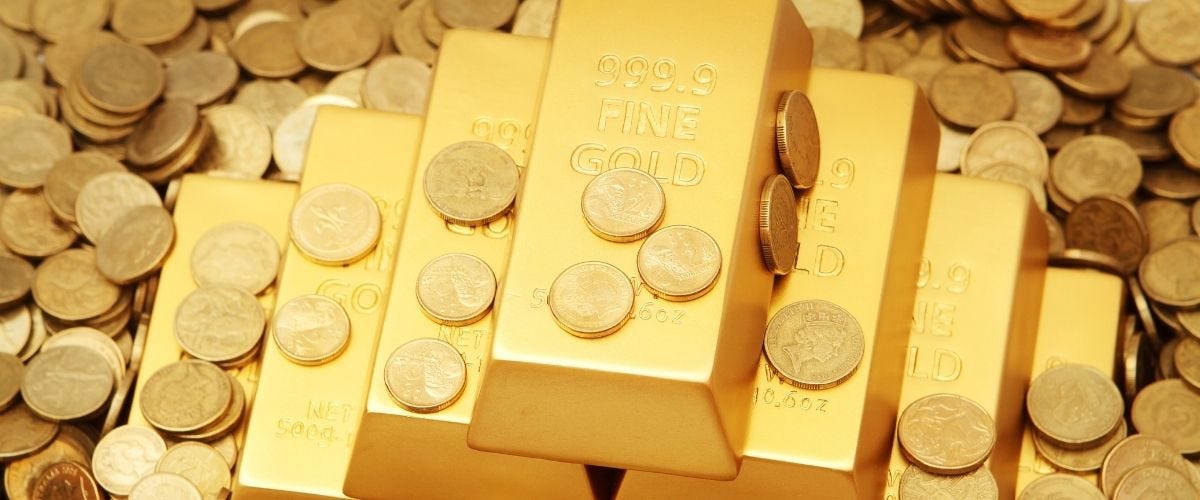Local Storage seems to be disabled in your browser.
For the best experience on our site, be sure to turn on Local Storage in your browser.
What Is the Gold Standard?

By GovMint :
For thousands of years, economies began to develop through the exchange of livestock, grain, vegetables, and even cowrie shells. Lydia, a kingdom in western Asia Minor, altered the course of history in about 600 BC by starting to use coins as media of exchange. The coins were valued based on their weight and metal content, and the original gold standard was born when the Lydians developed a method for separating gold from silver. However, they also continued to strike silver coinage.
Lydia’s use of gold and silver created the standard for what is today called “money,” as opposed to “fiat currency.” The characteristics that coins offered that previous media of exchange did not, or at least not in the same degree, were divisibility, durability, portability, scarcity, uniformity, and, at least in Lydia, universal acceptability. They were struck in standard sizes and eliminated the need to have more than two parties involved in most financial transactions. Historically, coins struck from precious metals have served as money for thousands of years, though civilizations have often strayed from them for various reasons. Over time and to varying degrees, alternatives have failed, and countries often return to standards of precious metals. Of these metals, gold and silver have been most frequently used, though platinum and palladium have also played relatively minor roles at various times.
The Great Depression and the Gold Standard
World War I ended in 1918, and the ensuing decade saw a global economic boom. Known as “the Roaring Twenties,” the period saw the development of the automobile industry, improvements in infrastructure, and American innovation at its finest. In 1928, though, the Federal Reserve (“the Fed”) raised interest rates in hopes of reigning in inflation. The raising of interest rates was one factor in the stock market crash of 1929. Bank failures followed in the ensuing two years, and Americans began to hoard gold. Britain abandoned the Gold Standard in 1931. Other European countries followed.
With the large-scale instability and failure of banks, Americans began hoarding gold. In response, President Franklin Delano Roosevelt signed Executive Order 6102, which required Americans to exchange nearly all forms of gold on or before May 1, 1933, at a rate of $20.67 per ounce. The following January, Roosevelt signed the Gold Reserve Act, which required the Fed to surrender gold certificates to the Treasury Department. He then set the price of gold at $35 per ounce. This price enabled the U.S. government to inflate the money supply.
Roosevelt’s actions on gold and his New Deal did help to begin growing the American economy again, albeit slowly. Ultimately, though, the United States and the rest of the world would not fully emerge from the Great Depression until about 1939, when production ramped up for the Second World War.
When Did the Gold Standard End?
A little more than two decades after World War II, President Lyndon Johnson’s spending on the Vietnam War and his Great Society programs resulted in increased imports and a balance of payments deficit. The Fed responded by raising interest rates to 6% in 1968 and to 9.19% in 1969, the first year of President Richard Nixon’s administration. The rise in interest rates created a recession and increased the unemployment rate to 6.1%.
Fifteen months from his next election, President Nixon announced wage and price freezes. Along with them came announcements that the Fed would stop redeeming dollars with gold, an effective unilateral end to the Bretton Woods Agreement, and a 10% import tax. Nixon’s policies proved popular enough to win him reelection, but they also created a recession that began in 1973.
In 1973, Nixon changed the dollar value of gold to $42. The situation became a crisis when Great Britain attempted to redeem $3 billion worth of gold. Fort Knox didn’t have enough gold to make the payment, so Nixon decoupled the dollar from gold. This decoupling brought an end to a century of the Gold Standard.
Nixon’s economic policies resulted in “stagflation” from 1973-1975. The term “stagflation” refers to a stagnant economy combined with inflation. In the ensuing years, the Fed’s raising and lowering of interest rates resulted in confusion among business owners and operators. Stagflation finally ended with the increase of interest rates to 20% in 1980, though that resulted in a recession in the early 1980s.
Fiat Currency
When Nixon decoupled the dollar from gold, he rendered it “fiat currency.” Latin for “let it be done,” fiat indicates that the currency is valuable because the government says that it is valuable rather than because it has intrinsic value. Governments typically make it valuable by requiring that it be accepted for the repayment of debt.
Today, fiat currencies, namely the euro and the dollar, dominate the global economy. Roughly three-quarters of other currencies, though, are tied either firmly or loosely to a major fiat currency or a combination of them. Fiat currencies offer both short-term advantages and long-term risks. They make it easier for governments to fund programs and for banks to stimulate economies. The risk is that banks issue too much currency and create hyperinflation, dramatically reducing or even effectively eliminating the value of the currency entirely. The best-known recent example of this was in Zimbabwe, where year-on-year inflation was estimated at 89.7 sextillion percent in November of 2008. Fiat currencies also diminish the values of savings held in them, whereas the gold standard keeps the value of savings reasonably constant.
Can We Go Back to the Gold Standard?
In 2008 and 2012, then-Congressman Ron Paul ran for President. One of his key issues was the advocacy of a return to the Gold Standard. This idea took hold among his supporters and a considerable portion of the Tea Party movement. The idea has since ebbed in the Republican Party, which has engaged in trillions of dollars in deficit spending in recent years. It has virtually no support among Democrats.
While a return to the gold standard has receded from the national spotlight, a small but ardent campaign for the change lives on. That is unlikely to go away entirely unless and until the United States and the world return to it.
Whether the U.S. should return to the Gold Standard is debatable. What is not debatable is how disruptive such a change would be. The price of gold itself would have to go up around five-fold, or $10,000 an ounce, for the dollars currently in circulation to match American gold reserves, causing massive inflation.
While a return to a standard of precious metals, be it gold, bi-metallic (with silver), or a more complex system involving other metals, is unlikely in the near future, gold’s legacy remains strong. Financial advisors continue to recommend that their clients hold a portion of their portfolios in metals as a hedge against inflation. Perhaps most significantly, gold retains its status as a safe haven in times of economic uncertainty.
© 2024 Copyright GovMint.com. All Rights Reserved. GovMint.com does not sell coins and numismatics as investments, but rather as collectibles. Please review GovMint's Terms and Conditions, Terms of Use and Privacy Policy before using this website and prior to purchasing from GovMint.com.










